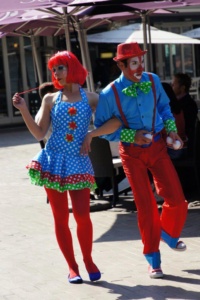Clown
Clown juggler magician hire
Circus shows, corporate events and parties and functions. Add that Clown to your function, sit back and laugh. Clown do balloons and juggling
Interesting facts on Clown for hire
History Clown juggler magician hire
The most ancient clowns have been found in the Fifth Dynasty of Egypt, around 2400 BC.[5] Unlike court jesters,[dubious – discuss] clowns have traditionally served a socio-religious and psychological role, and traditionally[when?] the roles of priest and clown have been held by the same persons.[5] Peter Berger writes, “It seems plausible that folly and fools, like religion and magic, meet some deeply rooted needs in human society.”[6] For this reason, clowning is often considered an important part of training as a physical performance discipline, partly because tricky subject matter can be dealt with, but also because it requires a high level of risk and play in the performer.[7]
In anthropology, the term clown has been extended to comparable jester or fool characters in non-Western cultures. A society in which such clowns have an important position are termed clown societies, and a clown character involved in a religious or ritual capacity is known as a ritual clown.[8][9][10]
Many native tribes have a history of clowning, such as the Pueblo clown of the Kachina culture. A Heyoka is an individual in Lakota and Dakota cultures who lives outside the constraints of normal cultural roles, playing the role of a backwards clown by doing everything in reverse. The Heyoka role is sometimes best filled by a Winkte. Canadian First Nations also feature jester-like ritual performers, translated by one Anishinaabe activist as “Harlequins”, though the exact nature of their role is kept secret from non-members of the tribe into the present day.[11]
The Canadian clowning method developed by Richard Pochinko and furthered by his former apprentice, Sue Morrison, combines European and Native American clowning techniques. In this tradition, masks are made of clay while the creator’s eyes are closed. A mask is made for each direction of the medicine wheel. During this process, the clown creates a personal mythology that explores their personal experiences.
“Grimaldi was the first recognizable ancestor of the modern clown, sort of the Homo erectus of clown evolution. Before him, a clown may have worn make-up, but it was usually just a bit of rouge on the cheeks to heighten the sense of them being florid, funny drunks or rustic yokels. Grimaldi, however, suited up in bizarre, colorful costumes, stark white face paint punctuated by spots of bright red on his cheeks and topped with a blue mohawk. He was a master of physical comedy—he leapt in the air, stood on his head, fought himself in hilarious fisticuffs that had audiences rolling in the aisles—as well as of satire lampooning the absurd fashions of the day, comic impressions, and ribald songs.”
The circus clown tradition developed out of earlier comedic roles in theatre or Varieté shows during the 19th to mid 20th centuries. This recognizable character features outlandish costumes, distinctive makeup, colorful wigs, exaggerated footwear, and colorful clothing, with the style generally being designed to entertain large audiences.[12]





